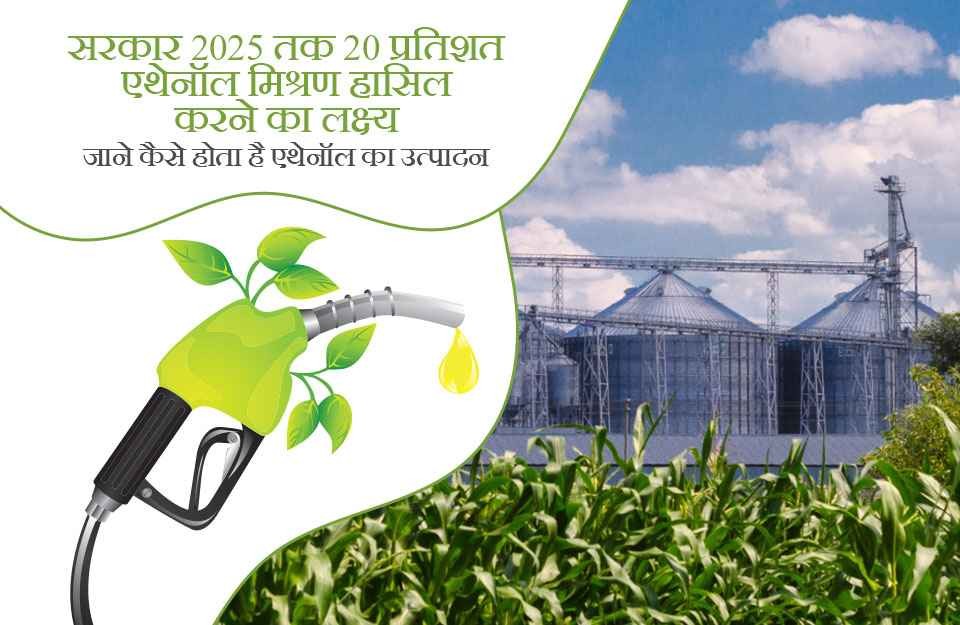
The government is preparing to achieve a 20% ethanol blending target by 2025 and aims for an even higher percentage by 2029-30. Additionally, there are plans to enable heavy machinery in the industry to operate on ethanol and flex fuels. India has significantly expanded its energy infrastructure, and there are now a total of 81,529 PSU retail outlets across the country. Out of these, 13,569 outlets now provide ethanol-blended petrol (E20). The country's ethanol production capacity is approximately 1,380 crore liters, with around 875 crore liters being molasses-based and about 505 crore liters being grain-based. During the 2023-24 period, under India's G20 presidency, discussions on energy transition have been held on various topics. Efforts have been made to bring together 24 countries and 12 international organizations, including the World Economic Forum, World Bank, and Asian Development Bank.
Ethanol is a type of natural fuel used as a fuel additive in vehicles to reduce pollution. It is commonly blended with gasoline to create biofuel. Ethanol, also known as ethyl alcohol or grain alcohol, is considered a renewable energy source because it can be produced from agricultural crops such as corn, sugarcane, or cellulosic biomass.
According to a report, India aims to achieve a 20% ethanol blending target by 2025. As of April 2024, ethanol-blended petrol (E20) is already available at 13,569 out of 81,529 total PSU retail outlets. The country has also conducted successful studies on E27 fuel and ethanol-blended diesel fuel. The Indian government is implementing the Ethanol Blended Petrol (EBP) program nationwide, where oil marketing companies (OMCs) sell petrol blended with ethanol. To achieve the 20% blending target by 2025, approximately 1,016 crore liters of ethanol will be required, and the total requirement for ethanol, considering other uses, is 1,350 crore liters. To meet this demand, ethanol production capacity needs to reach about 1,700 crore liters, assuming plants operate at 80% efficiency. To boost ethanol production capacity, the government has notified various ethanol interest subsidy schemes.
Union Minister for Petroleum and Natural Gas, and Housing and Urban Affairs, Mr. Hardeep Singh Puri, has launched the revolutionary automotive fuel 'Ethanol 100'. Consumers can now avail themselves of Ethanol 100 at 183 select retail outlets in five states: Maharashtra, Karnataka, Uttar Pradesh, New Delhi, and Tamil Nadu. Launching this pioneering fuel, Mr. Puri stated that the Ethanol 100 initiative is inspired by the Prime Minister’s vision of transforming farmers into energy providers. Describing Ethanol 100 as a revolutionary fuel, the Minister emphasized its potential to transform the transportation sector and reduce dependence on fossil fuels.
In India, most ethanol production is derived from sugarcane or molasses, while the rest is grain-based. According to government data, ethanol production increased from 380 million liters in 2013-14 to over 4,080 million liters in the ethanol supply year 2021-22, a more than tenfold increase. Approximately 11% of ethanol production uses surplus rice from the Food Corporation of India, and about 5% comes from damaged grains. Ethanol is primarily produced from sugarcane juice and heavy molasses but can also be made from corn, wheat, and barley. After production, ethanol is blended with gasoline to create biofuel. This can be in the form of E10 (10% ethanol) or E85 (85% ethanol). Vehicles equipped with flex-fuel technology can run on E85.
The government has taken this step to reduce import dependency, conserve foreign exchange, and promote the agricultural sector. Following the Prime Minister's announcement, the availability of E20 increased to 12,000 outlets in less than a year, bringing the target of 20% ethanol blending by 2025-26 within reach. Over the past decade, these ethanol blending initiatives have increased farmers' incomes, boosted rural employment, reduced CO2 emissions equivalent to planting 17.5 million trees, and saved 85,000 crore rupees in foreign exchange.
With the surging demand for petrol in India, NITI Aayog, the government's premier policy think tank, anticipates the country's petrol demand to hit 50.8 billion liters by 2025-26. A report from ARK Policy Research, a Delhi-based agriculture think tank, in 2023 revealed that to produce the requisite 10.16 billion liters of blended ethanol from three crops - sugarcane, corn, and rice, India will require approximately 275 million metric tons (MMT) of sugarcane, 6.1 MMT of corn, and around 5.5 MMT of rice.
Ethanol-blended petrol is hailed as a clean energy source that leads to reduced emissions. According to data, E10 vehicles emit 20% less carbon monoxide and hydrocarbons compared to conventional vehicles, while E20 vehicles emit 50% less carbon monoxide and 20% less hydrocarbons. In contrast, E20 vehicles emit 30% less carbon monoxide and 20% less hydrocarbons than conventional petrol vehicles. The research agency ICRA has affirmed that ethanol blending will not only aid in curbing vehicle emissions but also fortify energy security, diminish oil imports, and safeguard foreign exchange reserves.
Dr. A.K. Singh, the Director of the Indian Agricultural Research Institute (IARI), underscored the government's dedication to the welfare of farmers and the general public. The government's emphasis lies on initiatives such as Make in India and Made in India. The introduction of ethanol pumps will greatly benefit farmers, particularly those involved in cultivating crops like sugarcane, barley, grapes, and corn, as these crops are integral to ethanol production. Looking ahead, the government is strategizing significant advancements in ethanol production. Therefore, farmers stand to gain substantially if they concentrate on growing crops such as sugarcane, barley, grapes, and corn. Moreover, they can anticipate favorable prices for these products. Additionally, since ethanol production relies on by-products of sugarcane, sugarcane farmers will also reap its benefits.